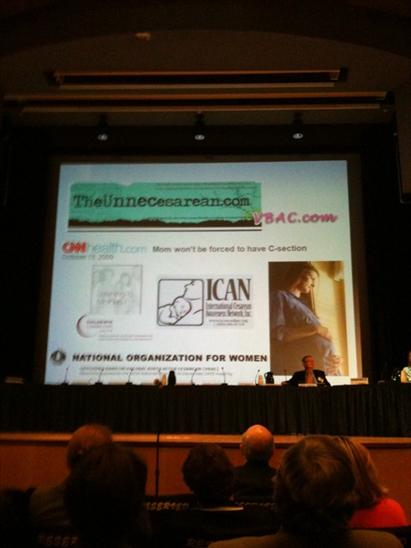With preparing for the Trust Birth Conference and trying to finish my book (more info on that in a week or so), I wasn’t able to keep up with my blog and all the excitement about the NIH conference. So a brief recap:
There was an awesome article in the New York Times about a hospital in a little town named Tuba City and how they have really low cesarean rates, support VBAC moms and have great outcomes for mom and baby! Take notice at how simple things, like having midwives care for low risk moms, helps reduce cesareans! Amazing.
I LOVE that at the conference they talked about blogs! Feminist Breeders put up a picture of it!
So the general consensus seems to be that the panel agreed that VBAC is no riskier than any other birth risk. For instance it is statistically about the same odds a random mom would have a cord prolapse (that would require an emergency cesarean) as a mom having a VBAC would have a rupture. So not allowing a mom to have a VBAC because of the “risk” is stupid.
NIH has said this and want ACOG to change their statement, so that they do not have to have immediate surgery available, then VBAC will be a true option for many women again. However, I don’t think any of us are holding our breath, thinking it will happen any time soon.
I think some women will still need to fight for their VBACs. I think it is great that they had this conference and hopefully those women can use the results as ammunition in their fight.
I love all the discussion going on at Unneccesarean. Visit there if you want to learn more! If you are passionate about VBACs, you need to add her to your blog roll!

What are the statistics on cord prolapse? I was looking around and one site cited stats ranging from .14% – .6%, another cited .25%. Isn’t rupture generally cited at between .5% and 1%?
I did read that the rate of placental abruption is 1% for all pregnancies — with a 20% – 40% rate of fetal death.
The rupture rate is about 0.8%, not all of those are catastrophic, meaning most mom and babies are fine after cesarean.
Hmm, I thought the rate of cord prolapse was about the same. But I could be wrong. I have looked around and found the statistics ranging from 0.3 – 0.62% depending on where you look.
So rather than saying more likely, it is about the same likelyhood.
Can’t wait for news about the book!